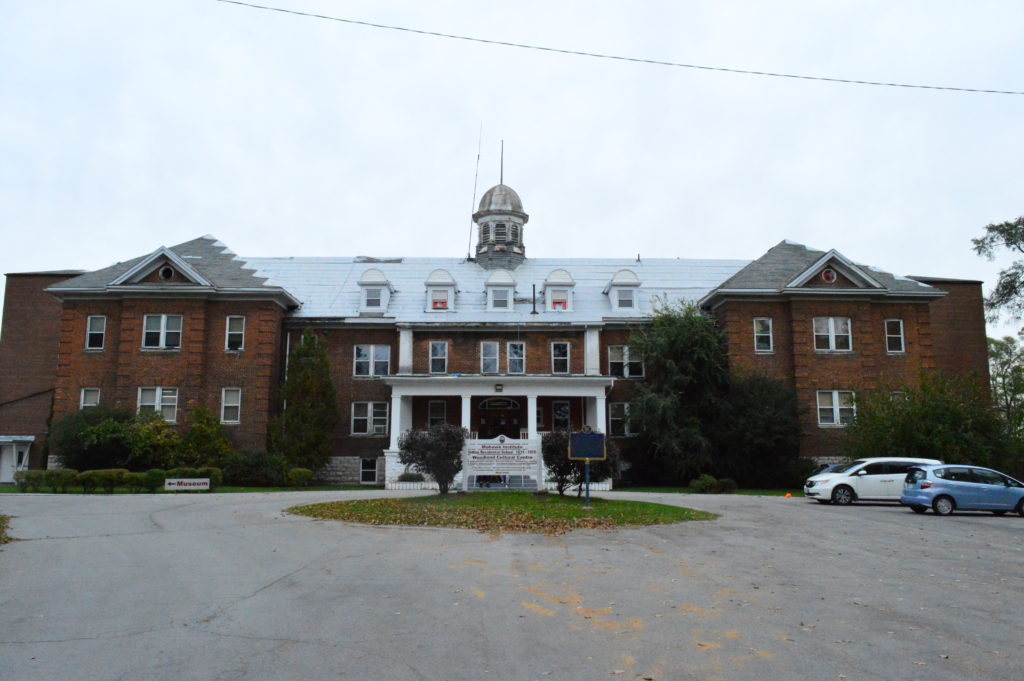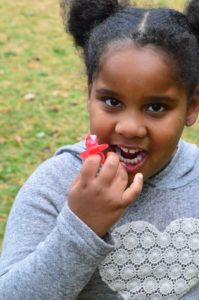Visit to Mohawk Institute Residential School provides a lesson on a dark chapter in Canadian history
It’s before eight in the morning when our group lines up canoes on the banks of the Grand River. The morning sun lends the frost-filled grass surrounding us the look of glass, while steam rising off of the immense 280 kilometer-long river makes the steam from our breath seem minuscule in comparison.
It’s an immediately memorable image on the final day of a Student Association (SA) sponsored trip to Six Nations of the Grand River, a First Nations reserve around 100 kilometers southwest of Toronto.

Six Nations reserve was originally six miles on each side of The Grand River, which is 280 kilometres long, by the Haldimand Treaty. Photo by Steve Cornwell / The Dialog
“It was a really fun activity and water is so important to First Nations communities,” said Leslie Van Every, who organized the three-day trip. Reflecting on that morning visit, Van Every fondly recalled the connection she felt to the Grand River.
But on a trip focused around truth and reconciliation, even the uncanny power and tranquility of the Grand River can only temporarily distract us as we prepare for a visit later in the day to the Mohawk Institute, a residential school, less than four kilometers southeast of Brantford.
JoJo Kruger’s parents both survived residential schools, and while she said that she knew about what happened in places like the Mohawk Institution, she wanted to see for herself where her mother and father came from. Not mincing words, Kruger, a student in the academic upgrading program, said she was disgusted by the sights and stories of the Mohawk Institution, particularly locks of hair, marbles and candy wrappers that children in school hid in the walls of the building.
“I wish I never went into the residential school. I was scared and after I left I started crying on the street.” said Kruger.

The Mohawk Institute Residential School was open from 1831 to 1970. Photo by Steve Cornwell / The Dialog
Calling the Mohawk Institute, and places like it, residential schools is too gentle of a term considering what happened there, according Elizabeth Doxtater, an award-winning artist who the group shared tea with.
Doxtater doesn’t hold back as she introduced us to a new set of terms on the trip, which, in her view, better reflect the history of how indigenous people were treated in Canada. Instead of residential schools, Doxtater prefers the name “Christian Canadian genocidal encampments.”
When I asked Doxtater about what she hopes settlers like me might take away from visiting Six Nations, she makes it clear that the term settler, like residential schools, erases the past.
“People didn’t come here and settle,” Doxtater said. “People came here and stole land and children and beat children and forced religion and committed genocide against our people. That’s not very settling for me, so I don’t like that word.”
While “Christian Canadian genocidal encampments” doesn’t easily roll off the tongue, it’s similar to the Truth and Reconciliation Commission’s description of the church-run boarding schools that separated more than 150,000 children from their parents, “primarily to break their link to their culture and identity.”
According to the commission’s final report, as late as the 1940’s, children in places like the Mohawk Institute were 4.9 times more likely to die than the general population.
The visit to Mohawk Institute, while it cast a shadow over the trip, was only one aspect of the retreat. For Van Every, who is also the SA’s First Nations, Métis and Inuit representative, the retreat was designed to provide both indigenous and non-indigenous students with an opportunity to learn more about the culture, heritage and traditions of Six Nations directly from the community itself.
As stories of Six Nations were offered during the trip, at stops like the Woodland Cultural Centre Museum and the Six Nations Polytechnic post-secondary school, it became clear that the community is determined to survive past traumas and thrive going forward.
For Carolyn Mooney, the SA’s accessibility representative, hearing stories of strength and resilience first hand has added a perspective not always available in George Brown classrooms.
“It’s actually really nice to be here and to hear a few little snippets of the strength of the people and how they’ve carried on,” she said. “I think that speaks volumes to how people can go through some devastating loses and still come through. That’s not an experience that we hear much of in my program.”
During a visit with Ava Hill, Six Nations’ elected council chief, the group heard about the First Nation’s efforts to restore or resolve the loss of their land. Close to 4,000 kilometres or six miles on either side of the Grand River, were set out in the 1784 Haldimand Treaty.
While large parts of the lands under the treaty were leased out long-term, 90 per cent of the leased land has never been “paid for or paid to Six Nations” according the council’s report, Land rights: A global solution. At present Six Nations’ lands are approximately five per cent of the area set out in the Haldimand Treaty. The report said that the original treaty land is now worth billions of dollars and runs through 33 separate municipalities.
At times, tempers flared during the trip, perhaps fed by some of the emotionally difficult content, or just the normal tensions of bringing people into close quarters for three days. A nail in one of the van’s tires deflated it twice, and led to a tense argument about whether the vehicle was safe to carry on. Other times, misunderstandings between members of the group affected people’s experiences on the trip.
“I think when you get a group of people together with different personalities and everybody’s individual differences and then you put them together for three days, you’re going to get a little tension here and there; I felt it,” said Jennifer Baptiste-Downie, a community worker student with Mohawk and Algonquin heritage. “But we went through it and a few of us leaned on each other, so it worked out.”
During some emotional moments, Van Every’s daughter Ariauna provided some comedic relief. One of her favourite activities was to pull her jacket behind her head run around and exclaim, “I’m a chicken!” During the canoe session on the Grand River, Arianuna’s chicken run probably helped encourage some in our group to put concerns of tipping over into the frigid water behind them and get paddling.
It’s possible too that some tense moments on the trip were fueled by how deeply connected some participants felt towards indigenous struggles in Canada. For Ron Greenberg, the SA’s business representative, his Jewish heritage has helped create an affinity with Indigenous Peoples.
“First Nations and Jewish people have each been subjugated or discriminated against or had to experience genocide in one form or another, and that creates a real kinship,” said Greenberg.
To say that the harrowing artifacts and stories of the Mohawk Institute were challenging is to say the least. But one can also focus on the humanity demonstrated in such inhumane circumstances.
When the masters of the school forebid boys and girls from communicating, some formed lifelong relationships with just daily eye-contact. As hunger and malnourishment affected the children at the Mohawk Institute, the boys that were sent into Brantford for supplies would find time to help themselves to the dumpsters of a nearby candy factory.
There were also the times that the Mohawk Institute was destroyed by fire, first in 1854, and then again in 1903. On the tour of the building, our guide suggested that fires were likely started deliberately by the children. Apparently, they had had enough of the “education” the institute provided.
In 2013, when the nearly dilapidated Mohawk Institute was at risk of being lost, members of the Woodland Cultural Centre started the save the evidence campaign. More than $2 million has been raised so far to help make sure that the institute remains, and this dark chapter of Canadian and First Nations history isn’t forgotten. The campaign’s goal is $10.5 million.
Whatever happens to the Mohawk Institute, there’s reason to believe that the terrible past it holds, as well as the promise of a place like Six Nations, has connected the participants of the trip, regardless of where we’ve come from. For Van Every that was one of the points of the trip.
“It’s a setting where we’re learning together, so it’s really bringing us together and making bonds stronger.”



